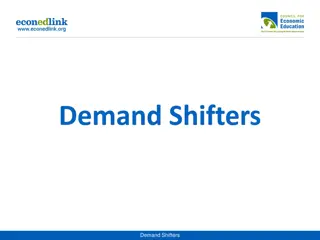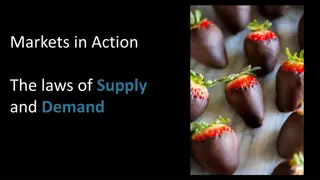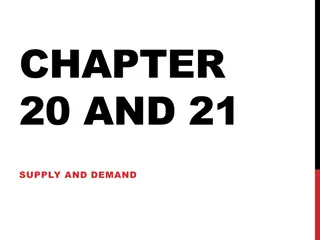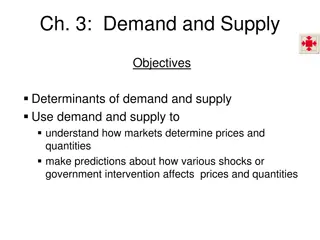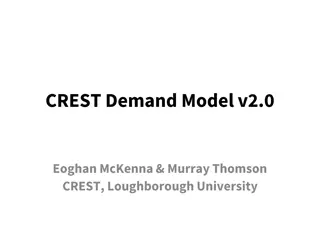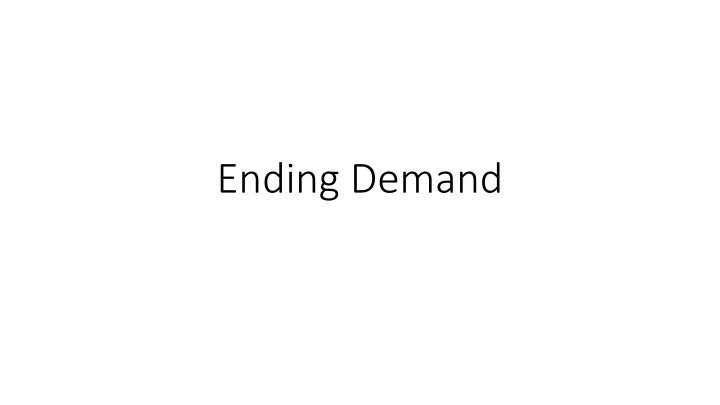
Insights into Sex Buying Behavior and Addiction Patterns
Discover the complexities surrounding sex buying behavior, including characteristics of sex buyers, their views on women, potential addiction indicators, assessment challenges, and tools utilized in evaluating sex offenders. Explore the various dimensions of this sensitive topic with a focus on understanding and addressing the issues at hand.
Download Presentation

Please find below an Image/Link to download the presentation.
The content on the website is provided AS IS for your information and personal use only. It may not be sold, licensed, or shared on other websites without obtaining consent from the author. If you encounter any issues during the download, it is possible that the publisher has removed the file from their server.
You are allowed to download the files provided on this website for personal or commercial use, subject to the condition that they are used lawfully. All files are the property of their respective owners.
The content on the website is provided AS IS for your information and personal use only. It may not be sold, licensed, or shared on other websites without obtaining consent from the author.
E N D
Presentation Transcript
Describing Sex Buyers Most importantly: Knowledge is limited No particular qualities that differentiate sex buying men from others1 Quality sex buyers do not have: purity morality2
What has been found concerning sex buyers? Egalitarian views on women3 Adverse Childhood Experiences (ACE) Buyers and sellers of sex have high scores when measuring ACE4 Display hostile views toward women (online) Thinking of women as prey in online forums reviewing sex buying5 Online forums also describe women as something to control6 Acceptance of rape myths and sexually aggressive behavior7
Defining Sex Buying as an Addiction Term and definition is not agreed upon Some terms include Sexual addiction8 Hypersexual disorder8 Problematic cybersex9 Compulsive sexual behavior- The broadest term9 None of these terms have made it into the DSM-V or the ICD-1110, 11 Speaking specifically of pornography use we have been unable to determine when use becomes pathological12 fMRIs show neural mechanisms acting similarly to gambling or substance use in response to pornography13 Negative symptoms are associated with treatment seeking14 At least one study has explored hypersexuality as a symptom of PTSD which can be treated with PTSD15
Assessments Have inconsistent terms and groupings Lack of assessment tool validated for women16 Gap: Most studies only evaluate men as sex buyers Gap: Not much known about protective factors, more research is needed to determine if this is a completely separate construct from risk factors17, 18
Sex Offender Assessments Static tools with a long history for evaluating sex offenders: Static-9919, Static-99R20, Static-2002/R20 Sex Offender Risk Appraisal Guide (SORAG)21 Assessing change can assist in risk appraisals and interventions (treatment assessment)22 Little is known about evaluating sex offenders over time18 Dynamic tools to assess change: Violence Risk Scale-Sexual Offender Version23 Stable 200023
More Specific Assessment Tools Child Pornography Offender Risk Tool (CPORT)24 Not valid for other types of offenders and not widely validated among child pornography offenders yet25 Tools for Assessing Hypersexuality/Sex Addiction There are least 32 assessment tools of hypersexuality.26Some include: Problematic Pornography Consumption Scale27 Hypersexual Disorder Screening Inventory28,29 Hypersexual Behavioral Consequences Scale30 Yale-Brown Obsessive-Compulsive Scale (Y-BOCS)31
Treatment of Sex Offenders Professionals aren t sure how to measure treatment17 Intensity and timing of treatment is still uncertain32 Prison has not been shown to be an effective part of treatment33
Areas of Exploration for Sex Offender Treatments John Schools (specifically for sex buyers)34 Self-regulation35 Positive, future-focused approach36 Treatment for women may look different For women, amount of problematic pornography use, negative symptoms associated with problematic pornography use, and religiosity may be associated with treatment seeking of pornography use37
Potential Means of Treatment for Sexual Addiction, Sexual Compulsion, Hypersexuality, etc. Many of these treatments were studied on small samples or are case studies: Cognitive Behavioral Therapy38, 39 In-patient treatment40 Individual Therapy40 Group Therapy40 12 Step Treatment40 Sponsor40 Art Therapy38 Ongoing Spiritual Life40 Support of Friends40 Mindfulness41 Pharmacological Treatments42 One study showed pharmacological treatments causing other problems43
Gaps Most studies only evaluate men as sex buyers No sex offender assessment tool has been validated for women44 Treatments are still in early stages of research with limited empirical support43 More research is needed to show validate assessments and improve treatments
Important but not sure where it fits Sex buyers are often not arrested even in cities that say they are using the End Demand approach45
References 1. Monto, M. A., & Milrod, C. (2014). Ordinary or peculiar men? Comparing the customers of prostitutes with a nationally representative sample of men. International journal of offender therapy and comparative criminology, 58(7), 802-820. 2. Silver, J. R., Pickett, J. T., Barnes, J. C., Bontrager, S. R., & Roe-Sepowitz, D. E. (2021). Why Men (Don t) Buy Sex: Purity Moralization and Perceived Harm as Constraints on Prostitution Offending. Sexual Abuse, 10790632211002859. 3. Brents, B. G., Yamashita, T., Spivak, A. L., Venger, O., Parreira, C., & Lanti, A. (2020). Are Men Who Pay for Sex Sexist? Masculinity and Client Attitudes Toward Gender Role Equality in Different Prostitution Markets. Men and Masculinities, 1097184X20901561. 4. Diamond-Welch, B., & Kosloski, A. E. (2020). Adverse childhood experiences and propensity to participate in the commercialized sex market. Child Abuse & Neglect, 104, 104468. http://dx.doi.org.ezproxy.liberty.edu/10.1016/j.chiabu.2020.104468 5. Bounds, D., Delaney, K. R., & Julion, W. (2017). Hunter-Prey Discourse: A Critical Discourse Analysis of the Online Posts of Men Who Buy Sex. Journal of the American Psychiatric Nurses Association, 23(4), 258-267. http://dx.doi.org.ezproxy.liberty.edu/10.1177/1078390317700264 6. Rosario Sanchez, R. (2016). The construction of masculinity in the online communities where men talk about their experiences as buyers in the sex trade. 7. Farley, M., Macleod, J., Anderson, L., & Golding, J. M. (2011). Attitudes and social characteristics of men who buy sex in Scotland. Psychological Trauma: Theory, Research, Practice, and Policy, 3(4), 369. 8. Karila, L., W ry, A., Weinstein, A., Cottencin, O., Petit, A., Reynaud, M., & Billieux, J. (2014). Sexual addiction or hypersexual disorder: different terms for the same problem? A review of the literature. Current pharmaceutical design, 20(25), 4012 4020. https://doi.org/10.2174/13816128113199990619 9. Sniewski, L., Farvid, P., & Carter, P. (2018). The assessment and treatment of adult heterosexual men with self-perceived problematic pornography use: A review. Addictive Behaviors, 77, 217-224. 10. Navarro-Cremades, F., Simonelli, C., & Montejo, A. L. (2017). Sexual disorders beyond DSM-5: the unfinished affaire. Current opinion in psychiatry, 30(6), 417 422. https://doi.org/10.1097/YCO.0000000000000367
References Continued 11. Kraus, S. W., Krueger, R. B., Briken, P., First, M. B., Stein, D. J., Kaplan, M. S., Voon, V., Abdo, C., Grant, J. E., Atalla, E., & Reed, G. M. (2018). Compulsive sexual behaviour disorder in the ICD-11. World psychiatry : official journal of the World Psychiatric Association (WPA), 17(1), 109 110. https://doi.org/10.1002/wps.20499 12. de Alarc n, R., de la Iglesia, J. I., Casado, N. M., & Montejo, A. L. (2019). Online Porn Addiction: What We Know and What We Don't-A Systematic Review. Journal of clinical medicine, 8(1), 91. https://doi.org/10.3390/jcm8010091 13. Gola, M., Wordecha, M., Sescousse, G., Lew-Starowicz, M., Kossowski, B., Wypych, M., Makeig, S., Potenza, M. N., & Marchewka, A. (2017). Can Pornography be Addictive? An fMRI Study of Men Seeking Treatment for Problematic Pornography Use. Neuropsychopharmacology : official publication of the American College of Neuropsychopharmacology, 42(10), 2021 2031. https://doi.org/10.1038/npp.2017.78 14. Gola, M., Lewczuk, K., & Skorko, M. (2016). What Matters: Quantity or Quality of Pornography Use? Psychological and Behavioral Factors of Seeking Treatment for Problematic Pornography Use. The journal of sexual medicine, 13(5), 815 824. https://doi.org/10.1016/j.jsxm.2016.02.169 15. Larsen, S. E. (2019). Hypersexual behavior as a symptom of PTSD: Using cognitive processing therapy in a veteran with military sexual trauma-related PTSD. Archives of sexual behavior, 48(3), 987-993. 16. Marshall, E., Miller, H. A., Cortoni, F., & Helmus, L. M. (2020). The Static-99R Is Not Valid For Women: Predictive Validity in 739 Females Who Have Sexually Offended. Sexual Abuse : A Journal of Research and Treatment. 17. Kelley, S. M., Ambroziak, G., Thornton, D., & Barahal, R. M. (2020). How Do Professionals Assess Sexual Recidivism Risk? An Updated Survey of Practices. Sexual Abuse : A Journal of Research and Treatment, 32(1), 3-29. http://dx.doi.org.ezproxy.liberty.edu/10.1177/1079063218800474 18. Helmus, L. M. (2018). Sex offender risk assessment: Where are we and where are we going? Current Psychiatry Reports, 20(6), 1-9. https://doi.org/10.1007/s11920-018-0909-8 19. Jung, S. (2018). Sexual Violence Risk Prediction in a Police Context. Sexual Abuse : A Journal of Research and Treatment, 30(5), 576-592. http://dx.doi.org.ezproxy.liberty.edu/10.1177/1079063216681563 20. Reeves, S. G., Ogloff, J. R. P., & Simmons, M. (2018). The Predictive Validity of the Static-99, Static-99R, and Static-2002/R: Which One to Use? Sexual Abuse : A Journal of Research and Treatment, 30(8), 887-907.
References Continued 21. Mogavero, M. C., & Hsu, K. (2018). Sex Offender Mobility: An Application of Crime Pattern Theory Among Child Sex Offenders. Sexual Abuse : A Journal of Research and Treatment, 30(8), 908-931. http://dx.doi.org.ezproxy.liberty.edu/10.1177/1079063217712219 22. Olver, M. E., & Stockdale, K. C. (2020). Evaluating change in men who have sexually offended: Linkages to risk assessment and management. Current psychiatry reports, 22(5), 1-1 23. Olver, M. E., & Wong, S. C. P. (2011). A comparison of static and dynamic assessment of sexual offender risk and need in a treatment context. Criminal Justice and Behavior, 38(2), 113-126. https://doi.org/10.1177/0093854810389534 24. Eke, A. W., Helmus, L. M., & Seto, M. C. (2019). A Validation Study of the Child Pornography Offender Risk Tool (CPORT). Sexual Abuse : A Journal of Research and Treatment, 31(4), 456-476. http://dx.doi.org.ezproxy.liberty.edu/10.1177/1079063218762434 25. Gottfried, E. D., Shier, E. K., & Mulay, A. L. (2020). Child Pornography and Online Sexual Solicitation. Current Psychiatry Reports, 22(3), 10. http://dx.doi.org.ezproxy.liberty.edu/10.1007/s11920-020-1132-y 26. Womack, S. D., Hook, J. N., Ramos, M., Davis, D. E., & Penberthy, J. K. (2013). Measuring hypersexual behavior. Sexual Addiction & Compulsivity, 20(1-2), 65-78. 27. B the, B., T th-Kir ly, I., Zsila, ., Griffiths, M. D., Demetrovics, Z., & Orosz, G. (2018). The development of the problematic pornography consumption scale (PPCS). The Journal of Sex Research, 55(3), 395-406. 28. Montgomery-Graham S. (2017). Conceptualization and Assessment of Hypersexual Disorder: A Systematic Review of the Literature. Sexual medicine reviews, 5(2), 146 162. https://doi.org/10.1016/j.sxmr.2016.11.001 29. Parsons, J. T., Rendina, H. J., Grov, C., Moody, R. L., Ventuneac, A., & Mustanski, B. (2019). The Hypersexual Disorder Screening Inventory. Handbook of Sexuality- Related Measures, 262. 30. Ko s, M., B the, B., Orosz, G., Potenza, M. N., Reid, R. C., & Demetrovics, Z. (2021). The negative consequences of hypersexuality: Revisiting the factor structure of the Hypersexual Behavior Consequences Scale and its correlates in a large, non-clinical sample. Addictive Behaviors Reports, 13, 100321.
References Continued 31. Kraus, S. W., Potenza, M. N., Martino, S., & Grant, J. E. (2015). Examining the psychometric properties of the Yale Brown Obsessive Compulsive Scale in a sample of compulsive pornography users. Comprehensive psychiatry, 59, 117-122. 32. Day, A., Ross, S., Casey, S., Vess, J., Johns, D., & Hobbs, G. (2019). The intensity and timing of sex offender treatment. Sexual Abuse, 31(4), 397-409. 33. Hsieh, M., Hamilton, Z., & Zgoba, K. M. (2018). Prison Experience and Reoffending: Exploring the Relationship Between Prison Terms, Institutional Treatment, Infractions, and Recidivism for Sex Offenders. Sexual Abuse : A Journal of Research and Treatment, 30(5), 556-575. http://dx.doi.org.ezproxy.liberty.edu/10.1177/1079063216681562 34. Lovell, R., & Jordan, A. (2012). Do John Schools Really Decrease Recidivism?. A methodological critique of an evalua-tionof the San Francisco First Offender Prostitution Program', July [online]. URL http://condor. depaul. edu/ssrc/documents/JohnSchoolsAndRecidivism. pdf [accessed 20 January 2021}. 35. Faust, E., Bickart, W., Renaud, C., & Camp, S. (2015). Child Pornography Possessors and Child Contact Sex Offenders: A Multilevel Comparison of Demographic Characteristics and Rates of Recidivism. Sexual Abuse : A Journal of Research and Treatment, 27(5), 460-478. http://dx.doi.org.ezproxy.liberty.edu/10.1177/1079063214521469 36. Harkins, L., Flak, V. E., Beech, A. R., & Woodhams, J. (2012). Evaluation of a community-based sex offender treatment program using a good lives model approach. Sexual Abuse : A Journal of Research and Treatment, 24(6), 519-543. http://dx.doi.org.ezproxy.liberty.edu/10.1177/1079063211429469 37. Lewczuk, K., Szmyd, J., Skorko, M., & Gola, M. (2017). Treatment seeking for problematic pornography use among women. Journal of Behavioral Addictions, 6(4), 445-456. 38. Wilson, M., & Fischer, B. (2018). Drawing out the shame: A comparative study on the effectiveness of art therapy with hypersexual adults. The Arts in Psychotherapy, 60, 19-25. 39. Hallberg, J., Kaldo, V., Arver, S., Dhejne, C., Jokinen, J., & berg, K. G. (2019). A randomized controlled study of group-administered cognitive behavioral therapy for hypersexual disorder in men. The journal of sexual medicine, 16(5), 733-745. 40. Carnes P. J. (2000). Sexual addiction and compulsion: recognition, treatment, and recovery. CNS spectrums, 5(10), 63 72. https://doi.org/10.1017/s1092852900007689
References Continued 41. Holas, P., Draps, M., Kowalewska, E., Lewczuk, K., & Gola, M. (2021). A pilot study of mindfulness-based relapse prevention for compulsive sexual behaviour disorder. Journal of Behavioral Addictions, 9(4), 1088-1092. 42. Winder, B., Lievesley, R., Elliott, H., Hocken, K., Faulkner, J., Norman, C., & Kaul, A. (2018). Evaluation of the use of pharmacological treatment with prisoners experiencing high levels of hypersexual disorder. The Journal of Forensic Psychiatry & Psychology, 29(1), 53-71. 43. Sniewski, L., Farvid, P., & Carter, P. (2018). The assessment and treatment of adult heterosexual men with self-perceived problematic pornography use: A review. Addictive Behaviors, 77, 217-224. 44. Marshall, E., Miller, H. A., Cortoni, F., & Helmus, L. M. (2020). The Static-99R Is Not Valid For Women: Predictive Validity in 739 Females Who Have Sexually Offended. Sexual Abuse : A Journal of Research and Treatment, 45. Rosentel, K., Fuller, C. M., Bowers, S. M. E., Moore, A. L., & Hill, B. J. (2021). Police Enforcement of Sex Work Criminalization Laws in an "End Demand" City: The Persistence of Quality-of-Life Policing and Seller Arrests. Archives of Sexual Behavior, http://dx.doi.org.ezproxy.liberty.edu/10.1007/s10508-020- 01910-9




